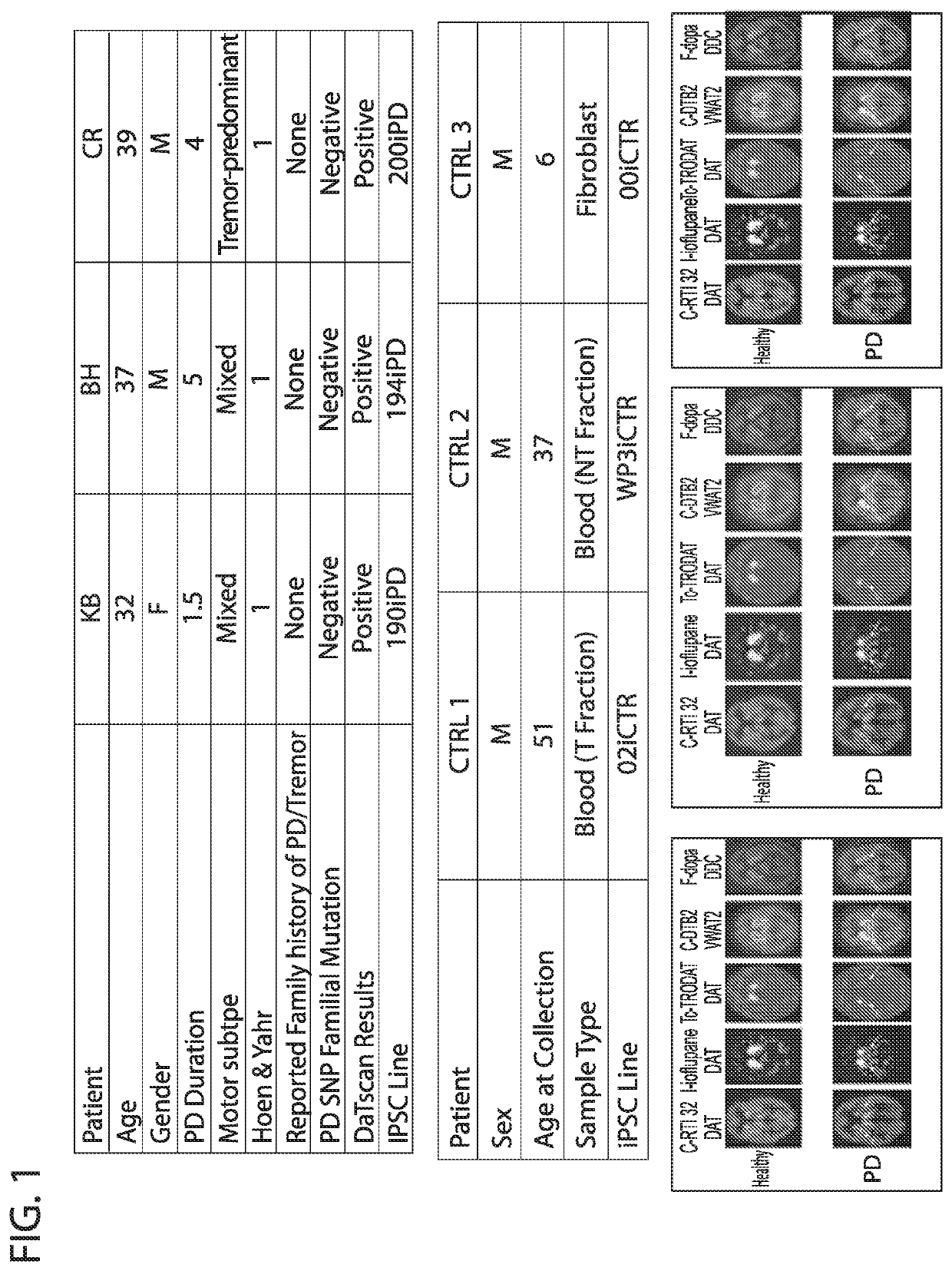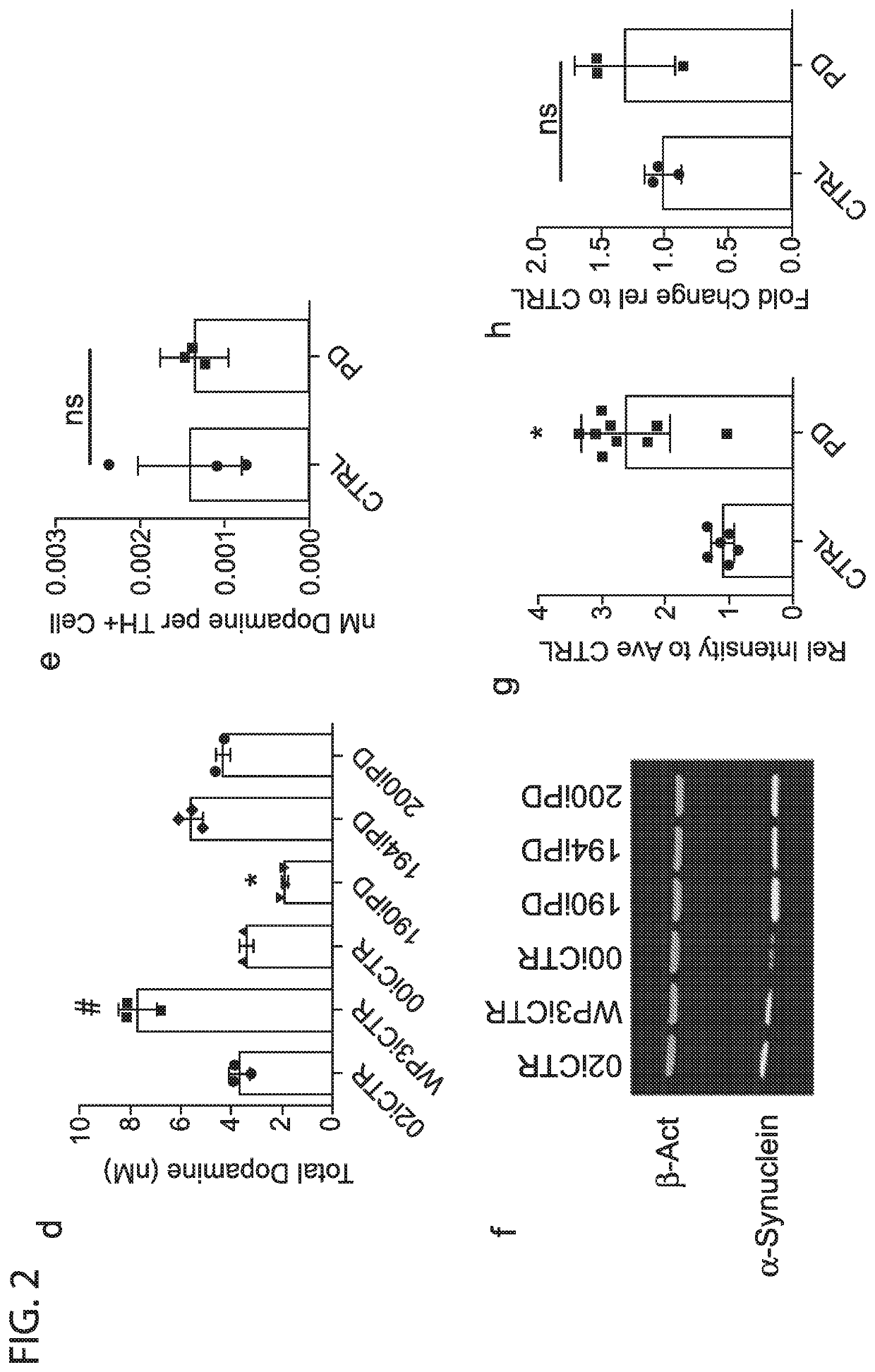Diagnostic and drug screening for molecular signatures of early onset sporadic parkinson's disease
a parkinson's disease, molecular signature technology, applied in the direction of apoptosis detection, drug composition, instruments, etc., can solve the problems of unanswered questions regarding the initiation and progression of the disease, the lack of effective pd models, and the substantial economic burden of current aging populations
- Summary
- Abstract
- Description
- Claims
- Application Information
AI Technical Summary
Benefits of technology
Problems solved by technology
Method used
Image
Examples
example 1
[0033]Generation of iPSCs from Early Onset Sporadic Parkinson's Disease Patients (EO-sPD)
[0034]Three early onset sporadic Parkinson's patients between the ages of 30-39 with no reported family history of PD were selected for iPSC production (FIG. 1). Based on analysis with the NeuroX platform, no monogenic mutations in EIFG1, PARK2, LRRK2, GBA, SNCA, PINK1, PARK7, VSP35, ATP13A2 or multiplications of the SNCA locus were detected in the patient lines. All 3 patients demonstrated reduced DAT (phenyltropane) signature in the striatum consistent with their PD diagnosis (FIG. 1). For comparison, 3 control lines were generated from normal individuals with no neurological disease at time of collection.
[0035]Peripheral blood mononuclear cells (PBMCs) were collected and subsequently reprogramed to iPSCs using non-integrating episomal techniques (FIG. 1). All iPSC lines were karyotypically normal, and expressed canonical pluripotency markers.
example 2
[0036]Efficient Differentiation of EOSPD iPSCs to DANs A defining hallmark of PD is the specific loss of dopaminergic neurons in the substantia nigra and it is therefore of interest to differentiate iPSC along this lineage. iPSC lines from both PD and control patients were differentiated to dopaminergic neurons using the protocol described in Table 1, FIG. 2A and FIG. 6.
[0037]Briefly, iPSC lines were subjected to a modified dual SMAD-inhibition based floor plate induction protocol. Exposure to LDN / SB, followed by SHH / Purmorphamine / FGF8 and CHIR99021, thereafter including SB withdrawal and retinoic acid addition,support midbrain FP and DA neuron yield (see FIG. 1d). Further maturation was carried out in Neurobasal / B27 medium supplemented with AA, BDNF, GDNF, TGFβ3 and dbcAMP. The inclusion of retinoic acid, exclusion of retionoic acid from the early steps of differentiation are unlike any other known techniques. Remarkably, whereas reported protocols may take 80 to 130 days to produc...
example 3
α-Synuclein Accumulates Specifically in EOSPD DANs
[0040]The protein α-Synuclein abnormally accumulates within Lewy bodies in all forms of Parkinson's disease, and accumulation through duplication or triplication of the SNCA gene is known to lead to PD. However, it's exact role in sporadic PD remains uncertain and previous studies have not shown consistent differences in adult onset sporadic PD. To determine if α-Synuclein protein accumulated the cultures of early onset sporadic PD origin, the 6 lines were differentiated for 30 days and probed for soluble α-Synuclein by western blot.
[0041]Strikingly, all 3 EOSPD DAN lysates exhibited increased levels of α-Synuclein protein when compared to controls (FIG. 2f,g). For verification of α-Synuclein accumulation, an ELISA was conducted on both media supernatant and cell lysates. The supernatant concentration of α-Synuclein was below detection limits, and cell lysates confirmed a significant increase in α-Synuclein protein in the diseased li...
PUM
| Property | Measurement | Unit |
|---|---|---|
| temperature | aaaaa | aaaaa |
| temperature | aaaaa | aaaaa |
| temperature | aaaaa | aaaaa |
Abstract
Description
Claims
Application Information
 Login to View More
Login to View More - R&D
- Intellectual Property
- Life Sciences
- Materials
- Tech Scout
- Unparalleled Data Quality
- Higher Quality Content
- 60% Fewer Hallucinations
Browse by: Latest US Patents, China's latest patents, Technical Efficacy Thesaurus, Application Domain, Technology Topic, Popular Technical Reports.
© 2025 PatSnap. All rights reserved.Legal|Privacy policy|Modern Slavery Act Transparency Statement|Sitemap|About US| Contact US: help@patsnap.com



